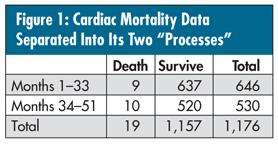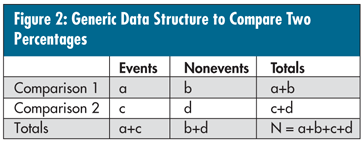Don’t let the calculation scare you; it looks worse than it is.
Given the data in my June column, “Percentage Deceptiveness,” suppose I wanted to compare the performance of months 1-33 (survival rate of 98.6%) vs. months 34-51 (survival rate of 98.1%). I could use a p-chart analysis of means (ANOM), but because of only one decision being made, the three standard deviation limits would be very conservative. Not only that, the problem of unequal denominators negates using ANOM’s more exact limits (1.39 standard deviations) for comparing two percentages at a 5-percent significance level. In cases like this, there is a nice alternative usually available in most good statistical software packages.
You can create what is called a “2 × 2 table” as shown in figure 1.

Figure 2 shows the generic structure of such data so that you can understand the needed statistical calculation.

The following formula results in a chi-square statistic with 1 degree of freedom. The calculation looks worse than it is, but your statistical software package should have something akin to a “2 × 2 table chi-square analysis” or contained as an option within “cross-tabs” procedures. The interpretation, however, is quite simple:
…
Comments
Add new comment